Top speed 480 km/h Length 17 m Retired 1957 | Wingspan 23 m Introduced 1938 First flight January 16, 1937 | |
 | ||
Lioré-et-Olivier LeO 45 was a French medium bomber used during World War II. It was a low-wing monoplane, all-metal in construction, equipped with a retractable undercarriage and powered by two 1,060 hp Gnome-Rhône 14N engines. The prototype had two 1,100 hp Hispano-Suiza engines. It was a very effective bomber but it appeared too late to give any substantial contribution to the war effort. Although designed before World War II, it remained in service until September 1957.
Contents
- The 1934 B4 bomber programme
- LeO 45 project
- Operational history
- Variants
- Operators
- Specifications LeO 451
- References
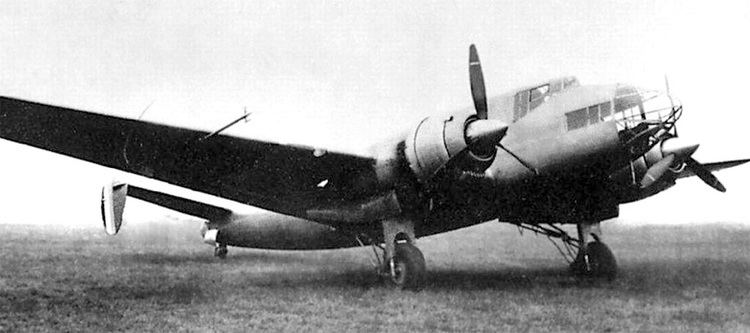
The 1934 B4 bomber programme

The LeO 451 was conceived as an advanced medium bomber for the new French Air Force. In contrast to its predecessors, which relied on machine guns for protection, the emphasis was placed on high-speed high-altitude cruise. The expectation was that high speed would force enemy fighters into tail-chase attacks and to that effect the aircraft was designed with a rear-firing cannon with an unobstructed rear arc of fire thanks to the design of the twin tailfins.
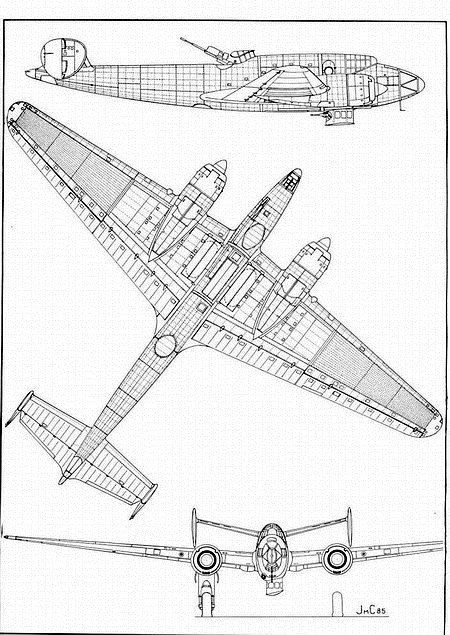
The Service Technique Aéronautique released the initial requirements on 17 November 1934, specifying a five-seat bomber with a top speed of 400 km/h (215 knots, 250 mph) at 4,000 m (13,125 ft) and a combat radius of 700 km (435 mi) carrying a payload of 1,200 kg (2,650 lb). In September 1936, the requirements were revised to account for development of 1,000 hp (746 kW)-class engines, with cruise speed raised to 470 km/h (255 knots, 290 mph) and crew reduced to four. Plan II called for 984 of the resulting B4-class bombers and numerous manufacturers submitted a proposal, including Latécoère, Amiot with its Amiot 351 and Lioré et Olivier, which was to be soon nationalized as part of the SNCASE.
LeO 45 project
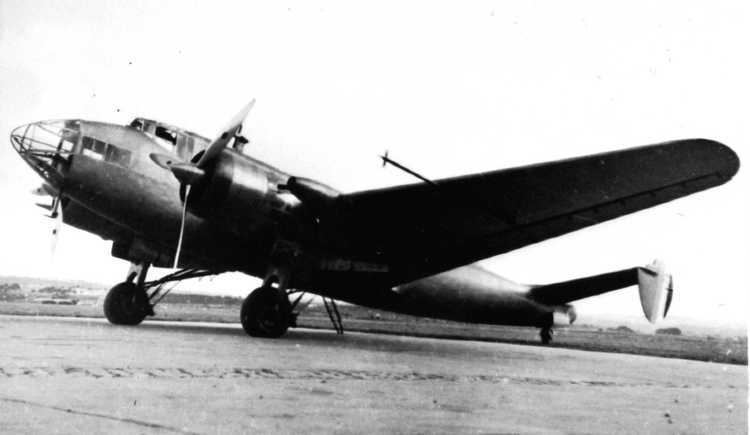
Lioré et Olivier was a long-time supplier to the Armée de l'air with its LeO 20 and other lesser-known biplane bombers, which had earned a reputation for reliability but were traditional in design. The 1934 programme was put under Pierre Mercier, a younger engineer with expertise in cantilever airframes. Mercier's work resulted in a design christened LeO 45, which was a twin-engined aircraft of all-metal construction, with a monocoque fuselage. Because of the speed requirements of the programme, a lot of effort was spent in reducing parasitic drag. Wings were equipped with slotted flaps and small bomb bays in the wing roots in addition to the main fuselage bomb bay, to minimise the fuselage cross-section. The wing structure was designed and patented by Mercier, in which the inner part used two spars, with enough room between them for a 200 kg-class bomb and large self-sealing fuel tanks; the spars did not continue to the wing-tip but made way for a box-type structure.
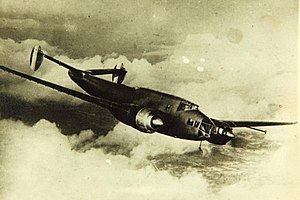
Mercier also used his patented type of fairing for the LeO 45's radial engines. Unlike typical NACA cowlings, flow adjustment was not provided by flaps but by a frontal ring that moved back and forth to respectively reduce or increase flow, without change in drag. Like many other French twin-engine aeroplanes of the era, the propellers rotated in opposite directions to eliminate the undesirable effects of propeller torque. The undercarriage was fully retractable, with an unusually complicated mechanism for the main wheels in order to reduce the size of the engine nacelles.
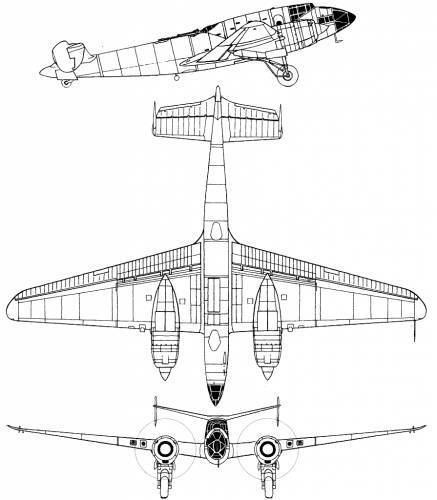
The fuselage housed the four-man crew with the bombardier, who was also the commander as per French tradition, in the glazed nose ahead of the pilot. Behind the pilot, the radio operator could man a defensive 7.5 mm M.1934 (500 rounds) machine gun from an underbelly retractable "gondola". A corridor alongside the main bomb bay led to the dorsal gunner's position, which featured a powered mounting for the 20 mm cannon Hispano-Suiza HS.404, with 120 rounds; the turret could be retracted. Another 7.5 mm machine-gun M.1934, was fixed in the nose (300 rounds). The LeO's armament was: 120 20 mm rounds, 800 7.5 mm rounds, up to seven 200 kg bombs or other combinations (1–2 500 kg bombs in the belly, plus the two 200 kg in the wings). The maximum load reduced the fuel load to only 1,000 lts. The fuel tanks were: two 880 lts (inner wings), two 330 and two 410 lts (all in the external wings).
The LeO 45-01 prototype, powered by a pair of Hispano-Suiza 14AA-6 / Hispano-Suiza 14AA-7 radial engines producing 1,120 hp (835 kW) each, flew for the first time on 16 January 1937. Despite problems with longitudinal instability, engine reliability and overheating, the aircraft demonstrated excellent performance, reaching 480 km/h (260 knots, 300 mph) at 4000 m and attaining 624 km/h (337 knots, 388 mph) in a shallow dive. In July 1938, the prototype fitted with the new Mercier cowlings reached 500 km/h (270 knots, 311 mph). The troublesome Hispano-Suiza engines were later replaced with Gnome-Rhone 14N 20/21 producing 1,030 hp (768 kW) each and the aircraft was renamed LeO 451-01.
As the international situation was worsening, the Armée de l'Air ordered the LeO 451, explicitly asking SNCASE not to delay production with further improvements, even though teething troubles were far from cleared.
Operational history
The first production LeO 451 was built in 1938. The decision to abandon Hispano-Suiza engines and a shortage of propellers resulted in production delays. The latter also caused most aircraft to be fitted with slower Ratier propellers, which reduced the top speed from 500 to 480 km/h. As a result, although 749 LeO 451 had been ordered, only 22 were delivered by the start of World War II. Of these, only ten were formally accepted by the Air Force. They were issued to a front line unit to experiment with the new type in the field and flew a few reconnaissance flights over Germany, which resulted in the type's first combat loss.
At the start of the Battle of France on 10 May 1940, only 54 of the 222 LeO 451s that had been delivered were considered ready for combat, the remainder being used for training, spares, undergoing modifications and repairs or having been lost. The first combat sortie of the campaign was flown by ten aircraft from Groupes de bombardement (bomber squadrons, abbreviated GB) I/12 and II/12 on 11 May. Flying at low altitude, the bombers suffered from heavy ground fire with one aircraft shot down and eight heavily damaged. Within the next eight days many of them were shot down, such as the one piloted by sergent-chef Hervé Bougault near Floyon, during a bombing mission over German troops. By the Armistice of 25 June 1940, LeO 451 of the Groupement de bombardement 6 (bomber wing) had flown approximately 400 combat missions, dropping 320 tons of bombs at the expense of 31 aircraft shot down by enemy fire, 40 written off due to damage and five lost in accidents. Other statistics state that about 47 bombers were lost: 26 to fighters, 21 to Flak. Although the LeOs were faster than many fighters and faster than almost all other types of bomber, unfortunately for them the Luftwaffe was equipped with fighters that were even faster (Bf-109 and 110). The cruise speed, up to 420 km/h (7 km/min), was one of the strengths of the LeOs performance and made them difficult to intercept. The diving and climbing speeds were very good as well (the Italian SM.79 took 17 minutes to reach 5,000 m, compared to 14 for the LeO), even if not that useful for a bomber. LeOs were optimized for medium-altitude operations (5,000 m) but were forced to go far lower to search for and destroy tactical targets, rarely with even a basic fighter escort (P-75, D.520). LeOs were not unarmed and German fighters had to keep a look out for their dorsal turret: on 6 June 1940, gunner sergeant Grandchamp, GB II/11 shot down two Bf-110Cs with the Hispano cannon. German fighters came to avoid this danger by attacking from below, forcing the LeOs to deploy their retractable turret, which slowed them. Another problem had been the Germans' initial strike. Groupement 6 had 50 LeOs but they were not dispersed and even lacked AA defence on their airfields. When the Luftwaffe attacked, 40 bombers were lost. In spite of this, Groupement 6 continued the fight, since the LeOs were produced at a fast pace (around 4–5/day, over 200 built within 45 days) allowing them to re-equip. Losses remained high and, on missions, 13 LeOs were intercepted and four shot down by Luftwaffe fighters. Groupement 6 totalled around 70 losses both in air and ground but still continued to fight until the end.
With Italy joining the war on the axis side, LeOs attacked Livorno, Novi Ligure, Vado and Palermo in a four-aircraft morning mission. Against Italy the LeOs operated without much difficulty. Turin (Fiat plants) was near the border and easy to reach. Italy did not possess a radar system and radios were not commonly used on the Italian fighters. On the other front, however, Flak and Luftwaffe took a heavy toll.
A total of 452 aircraft had then been built, 373 accepted into service (including 13 for the Aéronautique navale), and around 130 lost in action in Europe.
Following the Armistice, LeO 451s continued to fly, under the Vichy government. Modifications in Vichy service included fitting the aircraft with larger rudders and two more 7.5 mm machine guns in the rear turret. The extra weapons were added because of the limited capacity of the cannon magazines and the fact that changing them in flight was extremely difficult. Aircraft production had stopped with the German occupation but a 1941 agreement authorized Vichy authorities to have a limited number of military aircraft built and orders were placed for 225 newly-built Leo 451s. In order to speed production, considerable use was made of components that had been built in 1940 and stored in the German occupied zone. The first of the newly produced aircraft flew on 30 April 1942, and by the time the German occupation of Southern France following Operation Torch brought production to an end, 102 LeOs had been built for Vichy. In 1942, LeO 451-359 was fitted with an experimental degaussing coil for remotely detonating naval mines (some British Vickers Wellingtons and German Junkers Ju 52s also carried a similar device).
On 24 October 1940, Vichy French LeO 451s carried out an air raid against Gibraltar in retaliation for the Free-French attack on Dakar, losing one of their number to British anti-aircraft fire. Two bomber units equipped with LeO 451s, GB I/12 and GB I/31 were based in Syria when Allied forces invaded on 8 June 1941, at the start of the Syria-Lebanon Campaign. These were supplemented by GB I/25, which was dispatched from Tunisia. During this campaign, the LeO 451s flew a total of 855 sorties, losing 29 LeO 451s in the process. After Operation Torch which began on 8 November 1942, surviving French LeO 451 in North Africa were used primarily for freight duties, although they flew a few bombing missions against Axis forces during the Tunisia Campaign. They were replaced by Handley-Page Halifax and B-26 Marauder bombers.
The Germans were not especially interested in the type but on 21 May 1943, the Luftwaffe requested the Regia Aeronautica to hand over 39 LeO 451s captured by Italians troops in the SNCASE factory in Ambérieu-en-Bugey (Lyon). The Luftwaffe, claiming to have previously bought the Liorés, gave in exchange a stock of 30 Dewoitine D.520s. The 451s were converted into transport aircraft for fuel and troops. Other Liorés were delivered to the Regia Aeronautica and 12 were put in service with a ground attack unit, although they saw almost no active service.
Following the war, the 67 surviving aircraft were mostly used as trainers and transports. The LeO 451 was retired in September 1957, making it the last pre-war French design to leave active duty.
Variants
Operators
Specifications (LeO 451)
Data from Aircraft Profile 173
General characteristics
Performance
Armament
